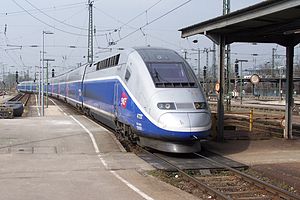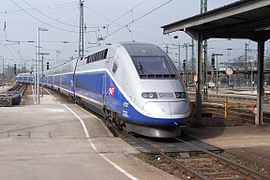
There are around 56,986 km (35,409 mi) of roads in Morocco. In addition to 1,808 km (1,123 mi) of highways.

The TGV is France's intercity high-speed rail service, operated mainly by SNCF. SNCF worked on a high-speed rail network from 1966 to 1974 and presented the project to President Georges Pompidou who approved it. Originally designed as turbotrains to be powered by gas turbines, TGV prototypes evolved into electric trains with the 1973 oil crisis. In 1976 the SNCF ordered 87 high-speed trains from Alstom. Following the inaugural service between Paris and Lyon in 1981 on the LGV Sud-Est, the network, centered on Paris, has expanded to connect major cities across France and in neighbouring countries on a combination of high-speed and conventional lines. The TGV network in France carries about 110 million passengers a year.

The TGV Atlantique (TGV-A) is a class of high-speed trains used in France by SNCF; they were built by Alstom between 1988 and 1992, and were the second generation of TGV trains, following on from the TGV Sud-Est trainsets. The trains were named after the Ligne à Grande Vitesse Atlantique that they were originally built for.

The SNCF TGV Réseau (TGV-R) is a TGV train built by Alstom between 1992 and 1996 for SNCF, the French national railway for use on high-speed TGV services. The Réseau trainsets are based on the earlier TGV Atlantique. The first Réseau sets entered service in 1993.
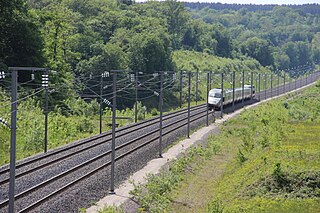
The Ligne à Grande Vitesse Est européenne, typically shortened to LGV Est, is a French high-speed rail line that connects Vaires-sur-Marne and Vendenheim. The line halved the travel time between Paris and Strasbourg and provides fast services between Paris and the principal cities of Eastern France as well as Luxembourg and Germany. The LGV Est is a segment of the Main Line for Europe project to connect Paris with Budapest with high-speed rail service.
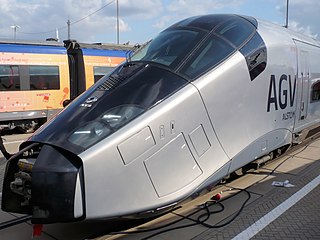
The AGV is a standard gauge, high-speed, electric multiple-unit train designed and built by Alstom.

The SNCF TGV Sud-Est was a French high speed TGV train built by Alstom and Francorail-MTE and operated by SNCF, the French national railway company. A total of 111 trainsets were built between 1978 and 1988 for the first TGV service in France between Paris and Lyon which opened in 1981. The trainsets were semi-permanently coupled, consisting of two power cars (locomotives) and eight articulated passenger carriages, ten in the case of the tri-voltage sets. The trains were named after the Ligne à Grande Vitesse Sud-Est that they first operated on. They were also referred to as TGV-PSE, an abbreviation of Paris Sud-Est.

The TGV POS is a TGV train built by French manufacturer Alstom which is operated by the French national rail company, the SNCF, in France's high-speed rail lines. It was originally ordered by the SNCF for use on the LGV Est, which was put into service in 2007. POS is an abbreviation of Paris-Ostfrankreich-Süddeutschland the route of the LGV Est.

The TGV Duplex is a French high-speed train of the TGV family, manufactured by Alstom, and operated by the French national railway company SNCF. They were the first TGV trainsets to use bi-level passenger carriages with a seating capacity of 508 passengers, increasing capacity on busy high-speed lines. While the TGV Duplex started as a small component of the TGV fleet, it has become one of the system's workhorses.
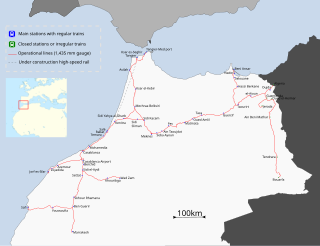
ONCF is Morocco's national railway operator. ONCF is a state-owned company that is under the control of the Ministry of Equipment, Transport and Logistics and is responsible for all passenger and freight traffic on the national railway network. The company is also responsible for building and maintaining the rail infrastructure.

The Perpignan–Barcelona high-speed line is an international high-speed rail line between France and Spain. The line consists of a 175.5-kilometre (109.1 mi) railway, of which 24.6 km (15.3 mi) are in France and 150.8 km (93.7 mi) are in Spain. It crosses the French–Spanish border via the 8.3-kilometre (5.2 mi) Perthus Tunnel bored under the Perthus Pass, connecting two cities on opposite sides of the border, Perpignan in Roussillon, France, and Figueres in Catalonia, Spain. The line extends to Barcelona, and this part is sometimes referenced as an extension of the Madrid–Barcelona high-speed rail line. The Perpignan–Barcelona line is a part of the Mediterranean Corridor.

Rail transport in Morocco is operated by the national railway operator ONCF. It was initially developed during the protectorate.
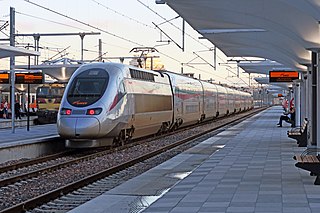
Al Boraq is a 323-kilometre (201 mi) high-speed rail service between Casablanca and Tangier in Morocco. The first of its kind on the African continent, it opened on 15 November 2018 after a decade of planning and construction by ONCF, Morocco's national railway company.

The Casa-Voyageurs Railway Station is an ONCF station in the Belvedere neighborhood of Casablanca.

France has a large network of high-speed rail lines. As of June 2021, the French high-speed rail network comprises 2,800 km (1,740 mi) of tracks, making it one of the largest in Europe and the world. As of early 2023, new lines are being constructed or planned. The first French high-speed railway, the LGV Sud-Est, linking the suburbs of Paris and Lyon, opened in 1981 and was at that time the only high-speed rail line in Europe.
Ouigo is a French low-cost service range of both conventional and high-speed trains. The literal translation of Ouigo from French to English is "yes go"; the name is also a play on words with the English homonym "we go." It is composed of two different services: Ouigo Grande Vitesse, which is a brand of SNCF operating high-speed trains; and Ouigo Vitesse Classique, a brand under which Oslo, a subsidiary of SNCF, operates conventional speed trains.

The SNCF Class CC 72000 was a class of C′C′ diesel-electric locomotives designed and built by French manufacturing conglomerate Alsthom. They are regarded as being the most powerful class of diesel locomotives to be built in France.
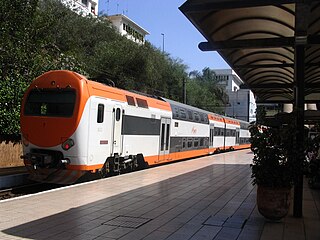
Train Navette Rapide is a Moroccan rail service operated by the ONCF. Its first phase runs from Casablanca to Kénitra with a half-hourly service in each direction, between 6 a.m. and 9.30 p.m. The concept was based on existing Moroccan transport links.
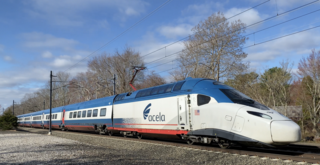
Avelia Liberty is a tilting high-speed passenger train built for the North American market by French manufacturer Alstom and assembled in the United States. Amtrak has ordered 28 train sets for use on its flagship Acela service along the Northeast Corridor between Boston and Washington, D.C., via New York City and Philadelphia.

The TGV M is a high-speed passenger train designed and produced by Alstom. It has a broadly similar design to the TGV Duplex sets, with bi-level carriages and a push–pull configuration with a power car on either end. However, it is more energy efficient and provides lower operating costs.
